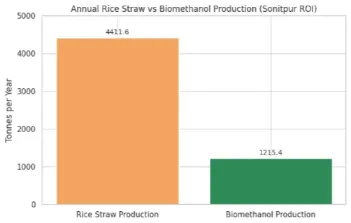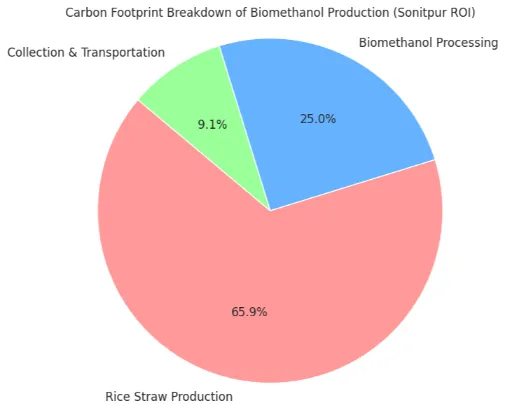Unlocking Rural India’s Clean Energy Future: Biomethanol from Rice Straw in Assam
India is at a crucial stage in its pursuit of sustainable growth, with clean energy solutions central to its development plans. Among the states, Assam shines due to its agricultural wealth and potential in renewable energy. This blog looks at how producing biomethanol from rice straw in Assam can transform rural energy systems, promote economic growth, and help India reach its clean energy goals.
Assam: The Green Heart of India’s Biomethanol Revolution
Agricultural Riches and Energy Challenges
Assam, located in Northeast India, is known for its rich fields and active agricultural sector. Almost half of its 78,438 square kilometers are cultivated, with rice as the main crop. Assam produces millions of tonnes of rice each year. However, this agricultural success leads to a significant by-product: rice straw. Often considered waste, rice straw is typically burned in open fields, causing severe air pollution and greenhouse gas emissions.
The Untapped Power of Rice Straw
Rice straw availability: In areas like Sonitpur, Assam, studies show an annual surplus of over 4,400 tonnes of rice straw from just 5,480 hectares of farmland. This surplus is enough to produce more than 1,200 tonnes of biomethanol per year, or about 3.3 tonnes per day, from a single group of villages.
Statewide potential: When considering the entire state, Assam’s total rice straw resource is enormous, making it an ideal candidate for local bioenergy production.
What Is Biomethanol? Why Is It a Game-Changer for Assam?
Biomethanol is a renewable fuel made from organic materials, such as agricultural waste. Unlike fossil methanol, derived from natural gas or coal, biomethanol is produced through the gasification of biomass, followed by cleaning the syngas and synthesizing methanol.
Why Biomethanol?
- Clean-burning: Biomethanol burns cleaner than fossil fuels, significantly lowering emissions of CO2, NOx, SOx, and particulate matter.
- Versatile applications: It can be mixed with gasoline, used as a feedstock in the chemical industry, or act as a hydrogen carrier for fuel cells.
- Circular economy: Turning agricultural waste into valuable fuel exemplifies a circular bioeconomy.
The Science: How Biomethanol Is Made from Rice Straw in Assam
The Gasification Pathway
- Collection and Pre-treatment: Rice straw is gathered from fields, dried, and pre-treated to lower ash content and enhance its suitability for gasification.
- Gasification: The straw undergoes partial oxidation at high temperatures to produce a syngas rich in hydrogen and carbon monoxide.
- Syngas Cleaning: Impurities like tar, particulates, and sulfur compounds are removed.
- Methanol Synthesis: The cleaned syngas is then transformed into biomethanol using catalysts.
Technical Innovations for Assam’s Rice Straw
High Ash Content Solutions: Assam’s rice straw has an ash content of 9 to 22%, which can cause operational problems. Advanced pre-treatment methods, like alkali treatment, and the use of cyclone gasifiers help prevent slagging and corrosion, ensuring smooth operations.
Energy Efficiency: Conversion efficiencies of 40 to 43% can be achieved, yielding about 0.275 to 0.308 kg of biomethanol per kg of rice straw.
Environmental Benefits: Biomethanol vs. Open Burning
The Pollution Problem
Burning rice straw is a significant environmental challenge in Assam and across India. Each tonne of straw burned releases:
- 1,460 kg of CO2
- 60 kg of CO
- 5.7 kg of CH4
- 0.07 kg of N2O
- Significant amounts of particulate matter, NOx, and SOx
Biomethanol’s Green Advantages
- Drastic Emissions Reduction: Biomethanol production from rice straw emits only 0.347 kg CO2e per kg of methanol, compared to 1,460 kg CO2 per tonne from burning.
- Cleaner Combustion: It reduces NOx emissions by up to 80%, CO2 by 95%, and eliminates SOx emissions entirely.
- Soil Health: It helps preserve beneficial soil microorganisms and maintains soil fertility, which is harmed by burning.
Economic Opportunity: Biomethanol as a Rural Game-Changer in Assam
Feedstock Economics
Low-cost resource: Delivered rice straw costs around INR 2.05/kg (USD 0.03/kg) for a 10 km transport, often less than the cost of burning or disposing of it.
Potential for negative cost: Farmers could be paid for providing straw, turning a disposal issue into a source of income.
Investment and Plant Economics
- Capital expenditure: A 50,000 tonne/year biomethanol plant requires a considerable investment, but costs decrease with size and government support.
- Operational costs: These are heavily influenced by feedstock price and plant size, with economies of scale being essential for profitability.
- Market prospects: The global biomethanol market is expanding quickly, with forecasts predicting high demand for sustainable fuels.
Government Support and Policy
- Subsidies and incentives: The Indian government provides capital subsidies, for example, INR 15,000/kW for biomass gasification, and encourages second-generation biofuels through policy frameworks.
- Carbon credits: The low carbon footprint of biomethanol can be monetized through carbon trading, increasing the project’s viability.
Socio-Economic Impact: Empowering Rural Assam
Job Creation
Value chain employment: Biomethanol projects generate a variety of rural jobs, from straw collection and transport to plant operation and maintenance.
Skill development: New technical roles in bioenergy help develop skills and support rural industry.
Farmer Income Enhancement
New revenue streams: Commercializing rice straw gives farmers a stable, additional income, replacing the less profitable practice of burning or selling it at low value.
Case studies: Other regions have shown that farmers can earn up to INR 2,500 extra per season by selling straw for bioenergy.
Local Energy Security
- Reduced fossil fuel dependence: Biomethanol production in Assam can help shield rural communities from unstable fossil fuel prices and supply disruptions.
- Distributed generation: Decentralized plants near straw sources lower transport costs and ensure a reliable local energy supply.
Biomethanol and Assam: Aligning with India’s Clean Energy Vision
National Priorities
- Methanol Economy Program: India’s initiative for a methanol economy aims to reduce crude oil imports, lower emissions, and improve rural incomes.
- Biofuel blending targets: Government rules for ethanol and methanol blending in fuels boost demand for sustainable options like biomethanol.
Assam’s Strategic Advantage
- Abundant feedstock: The consistent production of rice in Assam ensures a steady supply of straw, enabling year-round biomethanol production.
- Policy alignment: Assam’s state policies and India’s national biofuel strategies are aligning to support bioenergy investments and rural development.
Overcoming Challenges: From Field to Fuel
Logistics and Supply Chain
- Collection networks: Geographic Information System (GIS) technology helps map straw availability and create efficient supply chains, minimizing logistical costs.
- Decentralized model: Smaller, distributed plants near sources of feedstock will optimize operations and cut transportation emissions.
Technical Barriers
- Ash management: Innovations in pre-treatment and gasifier design tackle the high ash content of Assam’s rice straw, ensuring dependable plant operations.
- Seasonal supply: Effective storage and planning are necessary to handle the seasonal availability of rice straw.
Financial Feasibility
- Scale matters: Larger plants benefit from economies of scale, while using low-cost or negative-cost feedstock improves profit margins.
- Multi-pronged strategy: Combining subsidies, carbon credits, and efficient logistics is crucial for making projects financially viable.
The Road Ahead: Strategic Recommendations for Assam
- Promote decentralized biomethanol plants near rice straw clusters to maximize local benefits and reduce logistical challenges.
- Invest in advanced pre-treatment and gasifier technologies to manage Assam’s unique feedstock characteristics.
- Leverage government subsidies and carbon credits to improve financial returns and draw in investment.
- Involve local communities and farmers to ensure a stable supply chain and fair economic benefits.
- Integrate biomethanol into Assam’s clean energy plan, aligning with national biofuel goals and rural development objectives.
Conclusion: Assam’s Biomethanol Opportunity
Assam is on the brink of a clean energy transformation. By harnessing biomethanol from rice straw, the state can turn an environmental problem into an economic advantage. This initiative will create rural jobs, boost farmer incomes, and contribute significantly to India’s net-zero goals. The journey from rice field to fuel tank unlocks Assam’s clean energy future while offering a model for sustainable rural development throughout India.
Biomethanol is not just a fuel; it is a catalyst for change, a driver of rural prosperity, and a key part of Assam’s path toward a greener, more resilient future.
Want to Learn More About Assam’s Clean Energy Future?
Discover how rice straw is transforming energy production in Northeast India.
Explore More ResourcesFrequently Asked Questions (FAQ)
Q: What is biomethanol and how is it produced in Assam?
A: Biomethanol is a renewable fuel made by gasifying rice straw and converting the resulting syngas into methanol. Assam’s extensive rice fields offer an abundant, sustainable feedstock for this process.
Q: Why is biomethanol better than burning rice straw?
A: Biomethanol production greatly reduces greenhouse gas and pollutant emissions, enhances soil health, and provides economic benefits to farmers and rural communities.
Q: How does biomethanol support Assam’s rural economy?
A: By generating jobs, raising farmer incomes, and boosting local energy security, biomethanol projects strengthen rural Assam and promote sustainable growth.
This article was inspired by research from EastMojo.



